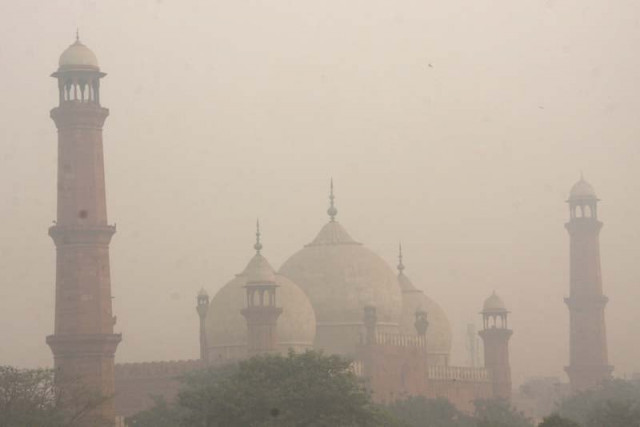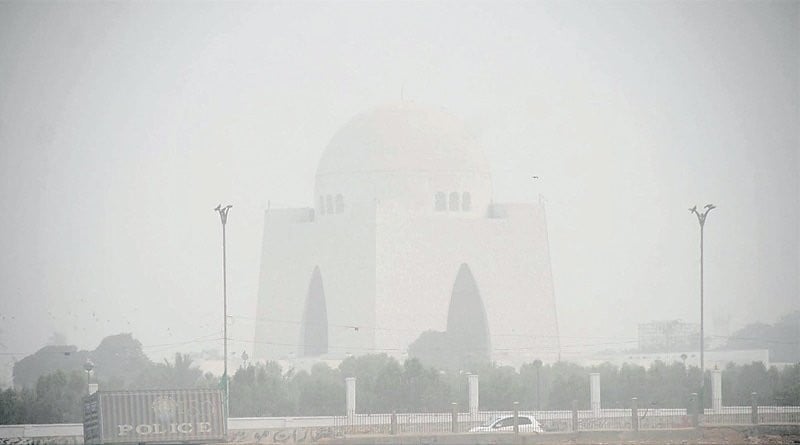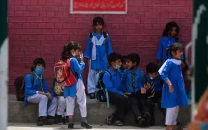As winter sets in, deadly smog chokes Pakistan
Thick pall of toxic air engulfs major cities in fall and early winter, triggering surge in respiratory diseases

In many places around the world, the advent of fall comes with a slow and beautiful change from green foliage to different hues of brown, red, yellow and orange.
There is an undeniable beauty to that season as the weather gets cooler and air crisper.
For residents of large parts of Pakistan and northern India, though, this is a long-forgotten experience, as they now herald the season with something else: toxic smog.
A thick pall of toxic air begins to engulf places like Lahore, Karachi and New Delhi in early November, cities that regularly top the list of metropolises with the worst air quality.
The problem is getting worse with every passing year, especially in northeastern Punjab compelling the government to shut down businesses, commercial activities, schools, and even highways.

Mazar-i-Quaid is enveloped in haze as smog-like conditions prevailed in the city. PHOTO: FILE
The combination of smog and smoke has left hundreds of people with sore throats and itchy eyes, with doctors advising them to stay indoors as much as possible.
Until a decade ago, Lahore, the capital of Punjab, was the only major Pakistani city facing the problem of smog.
However, the phenomenon has now spread to almost the entire province, home to over 127 million people, forcing the government to introduce “smart lockdowns” in 10 badly affected districts.
This year, smog has also engulfed Karachi, a commercial hub already among the world’s most polluted cities.
‘Holistic approach needed’
A report by the University of Chicago’s Energy Policy Institute published in August this year warned that increasing air pollution could cut the life expectancy of residents of Lahore, Peshawar, Kasur and Sheikhupura districts by at least seven years.
It also highlighted the adverse effects of smog on children, saying that being exposed to the current level of pollution is equivalent to smoking 30 cigarettes a day.
State meteorologists blamed the sudden rise in smog on wind from neighbouring India bringing smoke and other pollutants, mainly due to stubble burning by paddy farmers in India’s Punjab province.
They said smoke and pollutants had entered Lahore from Jalandhar in Indian Punjab, where farmers burn crop leftovers for the sowing season every year at the beginning of November.
Heavy smog has affected parts of both countries at the start of winter for the past several years, as authorities in India have failed to stop farmers from burning stubble despite repeated warnings.
Read also: Smog: the new unfortunate reality of Lahore
Environmentalists, however, say that is not the sole factor, especially in the big cities.
Rapidly changing climate conditions, along with vehicular and industrial emissions, are other key reasons for the persistently poor air quality, according to Imrana Tiwana, a Lahore-based environmentalist.
“Smog is not the only factor behind rising air pollution. It simply brings out the problem in this period of the year. We need a holistic approach to deal with this issue throughout the year,” she told Anadolu.
Vehicular emissions, she added, contribute 83% to air pollution in Lahore, with an average mean temperature increase of 10% over the past decade.
Once known as the “City of Gardens,” Lahore has lost 75% of its green cover over the past 10 years, she added.
Meager progress
Pakistan is among the countries most at risk from the ravages of climate change, although it accounts for less than 1% of global greenhouse gas emissions.
The country’s southwestern Jacobabad district is one of the hottest places on the planet. In June 2021, its highest recorded temperature reached an unbearable 52 degree Celsius (125 degrees Fahrenheit).
Air pollution prematurely claims an estimated 128,000 lives in Pakistan every year, according to Fair Finance Pakistan, a non-government body working to mitigate the impacts of climate change.
“Clamping down on stubble burning and bricks kilns has produced results to some extent,” Nazia Jabeen, director of Punjab’s Provincial Disaster Management Authority, told Anadolu.
She said enforcement of several short-term measures has reduced instances of stubble burning, leading to a decrease in air pollution during specific periods.

Motorcyclists drive through a thick blanket of smog in Lahore. PHOTO: EXPRESS
According to data recently released by Dawar Butt, an environmental policy specialist, crop fires in Punjab have reduced by nearly 60% over the past three years, compared to the average between 2016 and 2020.
Calling for a strict ban on crop burning, Tiwana, the environmentalist, said renewable alternatives like biogas, fodder and bioenergy should be introduced and made mandatory.
She also urged for the implementation of a ‘Decarbonisation and Emissions Reduction Plan’ to stem rising air quality challenges in cities like Lahore, Karachi, Faisalabad and Multan.
Endorsing her view, Jabeen said the overall impact of efforts to mitigate smog depends on the “comprehensive adoption of alternative practices and technologies, which is an ongoing challenge.”
“The government has also initiated several long-term measures that involve promoting sustainable agriculture practices, encouraging the use of machinery to manage crop residue, and investing in renewable energy sources to reduce dependence on traditional methods contributing to smog,” she added.



















COMMENTS
Comments are moderated and generally will be posted if they are on-topic and not abusive.
For more information, please see our Comments FAQ